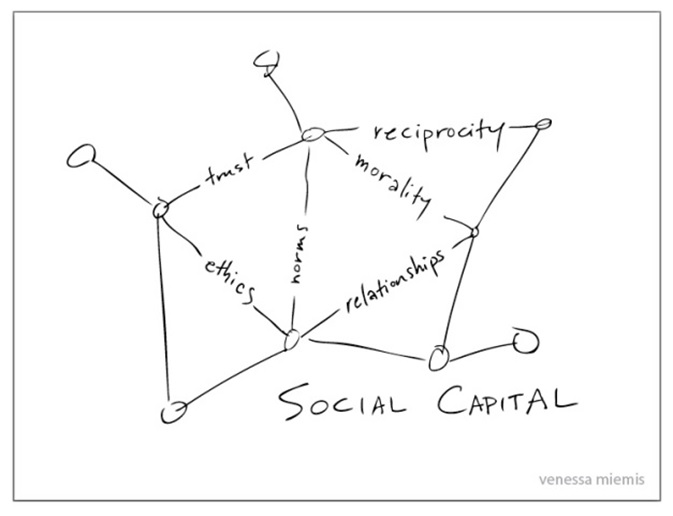A story of inequality
What careers teachers in the public sector might identify, quite rightly, is that young people who are typically from richer, better connected families, have something which has come to be called ‘social capital’. These children mainly go to public schools, which is the name we give to private, fee-paying schools.
The picture is by Vanessa Hall, who is a storyteller, creating community, whose work first interested me in 2016 – she was talking about the atmosphere in which ‘hacking’ became a word. I like her open description of the expression ‘social capital.’ I will talk about why in a forthcoming blog post.
Much is written about social capital. Organisations interested in social mobility focus on this for their beneficiaries. The Social Mobility Foundation is the foremost of these, and it is partly in response to their work, that this book was contemplated.
Is self-confidence the answer?
Sitting at the heart of what we call social capital is self-confidence. There are lots of books about how to be more self-confident, I have my favourites, which I will write about in due course, but at the core of this attribute, sits the ability to pay attention at will.
Its reach is so much wider than just confidence.
Without the ability to pay attention at will, it is difficult to make a start on having confidence – it’s like starting to move forwards without first learning that it can be done using one’s legs, straightened out, and the body held upright. Only then can one start to walk, and then gradually master running.
A book about paying attention
I am planning out a book to explore this for the teacher and the parent, so it becomes something we can, in either capacity, teach the younger people for whom we are responsible.
In this blog, I want to talk about how a corporate consultant like me came to write a book which is starting out as essentially about a single life skill.
Where did I find the evidence which made me believe that the core skill sitting at the heart of every other is this ability to pay attention at will? In workplaces in many countries and in homes across the globe: talking to senior managers, chief executives, parents and educators, this has been my take-away over a 30 year career. I will populate this blog with stories from workplaces, internship experiences, and family life, which will illustrate why this book is so necessary.
The life skills education movement
I have to thank a whole list of people who are responsible for me looking at life skills education at all. Right at the top of that list is Marlaine Cover, a life skills education activist, based in the US, with a worldwide reach. She has created a life skills report card, advocates professional education for life skills which are used daily for one and all, and holds a biennial conference for life skills educators. For what appeared to be the flimsiest of reasons (an article I had written on the Prowess Women’s Business Network) she invited me to speak at that conference in 2014.
This inspired bit of impulsiveness started me on a journey which has culminated in the writing of this book.
I will be writing in this blog about Marlaine and others who I have met at that conference – I have been to two such gatherings. All of them do wonderful work – some of them are truly inspiring teachers.
This will also be a blog about the process
I also have to thank Philip Calvert for setting up a book writing group. As a marketer, somewhat disarmingly, he tells us outright that this group, a paid service, is a part of his marketing funnel. He hopes so to impress us that one day we will hopefully join him in a highly priced retreat somewhere secluded and beautiful, where he will impart his greatest marketing wisdom presumably.
He adds value at every session however – he is good at this – and he teaches it as a craft, as someone who has made that same journey. Above all, he is keen to ensure that the work we do in the group and the book we produce will expand and support our core business.
I love what I have seen of his process so far. I will be dropping a hint or two about how he is doing this work.
References
The paper most quoted on the subject arrived at the turn of the last century, which outlines the distinct elements which can be attributed to career success. ‘Social capital was conceptualized in terms of network structure and social resources. Results of structural equation modelling showed that network structure was related to social resources and that the effects of social resources on career success were fully mediated by three network benefits: access to information, access to resources, and career sponsorship’.(Scott E. Seibert, (Apr., 2001)

Hi
this looks good